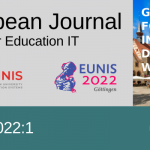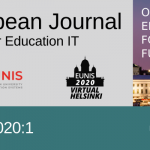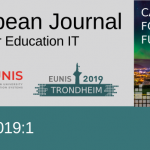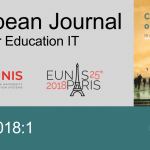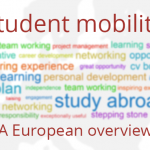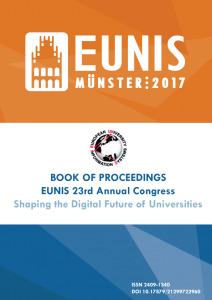Reference to articles in this issue should be made as follows:
name of author(s). title, European Journal of Higher Education IT 2017/2
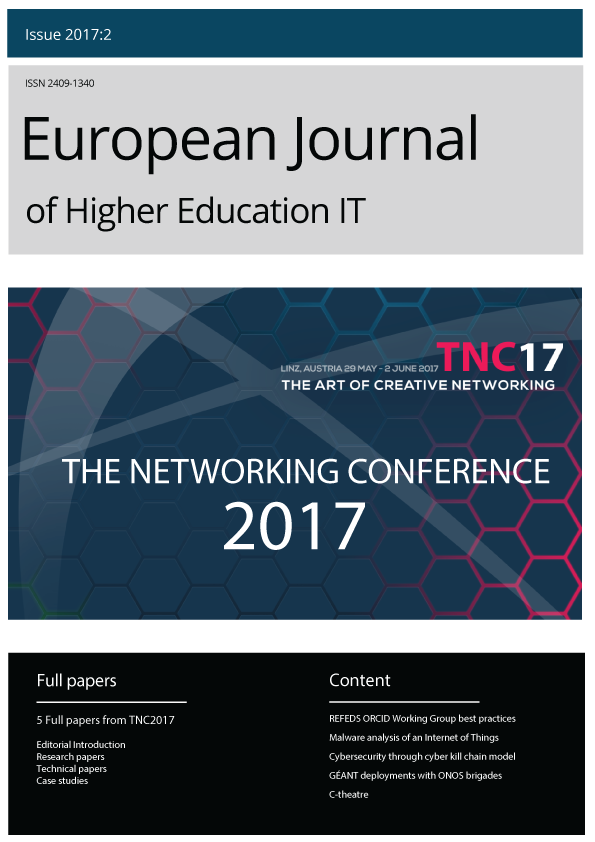
European Journal of Higher Education IT – EJHEIT
This issue of the European Journal of Higher Education IT (2017/2) consists of the full papers from the TNC17 congress. TNC is hosted by annually by GEANT and this is the second time GEANT publishes its full congress papers through EJHEIT. The theme of the conference was The art of creative networking.
TNC17, its 33rd edition, was hosted by the Austrian National Research and Education Network and held in Linz, Austria between 30 of May – 2nd of June 2017. The conference provided an opportunity for researchers, operators and suppliers of research and education networks in Europe and beyond to meet, present and discuss their latest results and requirements in an ideal environment for promoting collaboration
5 papers presented in parallel sessions were selected for this publication. These papers cover both research and practical approaches to some of the challenges faced by today’s research and education networks.
European Journal of Higher Education IT is a journal created to support and disseminate International research, case studies, interviews and more within the field of higher education IT. Editorial Committee
ISSN 2519-1764
Editorial Introduction
Johan Bergström, Nicole Harris
Abstract
TNC17 – The Art of Creative Networking
TNC17, its 33nd edition, was hosted by the Austrian NREN, Austrian Academic Computer Network (ACONET) and held in Linz, Austria between May 29th to June 2nd 2017. The conference provided an opportunity for researchers, operators and suppliers of research and education networks in Europe and beyond to meet, present and discuss their latest results and requirements in an ideal environment for promoting collaboration.
This year’s conference theme was “The Art of Creative Networking”. The theme has 2 meanings, both concerning the need to constantly evolve the service delivery whilst remaining agile in dialogue withcustomers. It is also aware of the fact that services provided by the NRENs are important to our artistic and cultural environment.There are many examples where high-speed connectivity has been paramount in securing a fully immersive experience of cultural expressions. This is something that is apparent in many of the presentations and papers coming from the conference.
Research paper
An extended analysis of an IOT malware from a blackhole network
Alexandre Dulaunoy, Gérard Wagener, Sami Mokaddem, Cynthia Wagner
Abstract
An extended analysis of an IOT malware from a blackhole network
The Internet of Things becomes more and more ubiquitous and new impacts in the landscape of classical network activities can be observed due to the fact of pervasive computing. This new kind of devices needs permanent connectivity, ranging from surveillance cameras to connected mattresses. This has also become a main trigger for a new threat landscape. Weak to no security features at all build a good starting point for attacking these kinds of devices. In this paper, we present some recent observations from a practical analysis of Internet of Things malware by inspecting traffic from a blackhole. We reviewed some old infections and assume that the clean-up of compromised machines is a long lasting process.
Case study
C theatre: light speed connected geo-distributed performances
Alex Barchiesi, Bruno Nati, Giancarlo Viola, Claudio Allocchio, Edoardo Angelucci, Elis Bertazzon, Paolo†Bolletta, Marco Paniccia, Andrea Salvati, Federica Tanlongo, Carlo Volpe
Abstract
C theatre: light speed connected geo-distributed performances
The pervasiveness of broadband connections and high capacity telecommunications networks have changed the way of conducting scientific research, how to learn and produce culture. The performing arts are no exception to this revolution.The new paradigm introduced with ultra-high speed networks growing both in commercial and research frameworks is triggering a redesign of the performing space that will be something else from theatre as we know it and will make William Shakespeare’s “all the world’s a stage” a feasible scenario also for real-time performances.
Given this premise GARR investigated in a synergy with a renowned experimental-theatre director, namely G.B. Corsetti, the possibilities offered by the physical fragmentation of the stage space.
Case study
How to use cyber kill chain model to build cybersecurity?
Ireneusz Tarnowski
Abstract
How to use cyber kill chain model to build cybersecurity?
The term “Cyber Kill Chain” has been widely used by the security community to describe the different stages of cyber attacks. This model is intrusion-centric, which was the focus of cyber security when it was created. They can be used for protection of an organization’s network. The stages are: Reconnaissance, Weaponization, Delivery, Exploit, Installation, Command & Control, Actions.
When combined with advanced analytics and predictive modeling, however, the cyber kill chain becomes critical for inside out security. With the above breakdown, the kill chain is structured to reveal the active state of a data breach. User behavior analytics brings advanced threat intelligence to every stage of the kill chain – and helps prevent and stop ongoing attacks before the damage is done.
The WASK network connects the academic institutions of Wrocław, providing them with access to Polish national network PIONIER and European network GÉANT2. The article describes how to prepare organization or metropolitan area network (MAN) to cyber attack. WASK team use a modern approach to cybersecurity in own network and implement security policy on the edge of network. All internal services are protected using application firewall (common name „next generation firewall”). Author using methodology based on cyber kill chain implement security policy to increase level of cyber security in network (exactly to defend all central services). Solution which is used, focus on detecting ongoing attacks — attackers that have already breached your perimeter — before the damage is done. Instead of analyzing old malware, deploy a breach detection system that automatically detects and analyzes the changes in user and computer behavior that indicate a breach. Mapping security controls and procedures to each stage of the kill chain, WASK security team will develop very detailed, result-oriented security procedures.
Article provides information how to understand kill chain model, how implement security policy to could respond on incident and how should look incident response procedures. All of that is important to build cybersecurity in data center.
Technical paper
REFEDS ORCID working group report
Melroy Almeida, Pål Axelsson, Tom Demeranville, Laure Haak, Keith Hazelton, Mikael Linden, Miroslav Milinovic, Laura Paglione, Chris Phillips, Hannah Short
Abstract
REFEDS ORCID working group report
In early 2016, Refeds formed the ORCID working group to discuss several topics related to ORCID identifiers (iDs) and their relationship to the Federated Identity Management (FIM) community. This document outlines the discussions of this group through early 2017, and summarizes the opinions of the working group of how ORCID interacts with the FIM community and the rationale behind it.
Case study
Empowering GÉANT deployments with ONOS brigades
Luca Prete, Alaitz Mendiola, Kostas Stamos, Pier Luigi Ventre, Andreas Papazois, Carolina Fernandez, Jordi Ortiz, Stefano Salsano, Afrodite Sevasti, David Boswell
Abstract
Empowering GÉANT deployments with ONOS brigades
GÉANT has recently joined ONOS core members and other affiliated organizations in a working group called “deployments brigade”. The goal of the brigade is to create a SDN open-source software stack based on ONOS that can be deployed by Research Education Networks (RENs) and Operators. After only a few months of work the brigade released non-trivial software components, already part of field trials within GÉANT. This document explains a) GÉANT requirements and motivations to join the project; b) the concept of ONOS brigades and the goals of the deployment working group; c) the infrastructure and the software stack under development and how GÉANT and its associates intend to test and deploy it; d) the goals achieved and the tasks still in progress.

